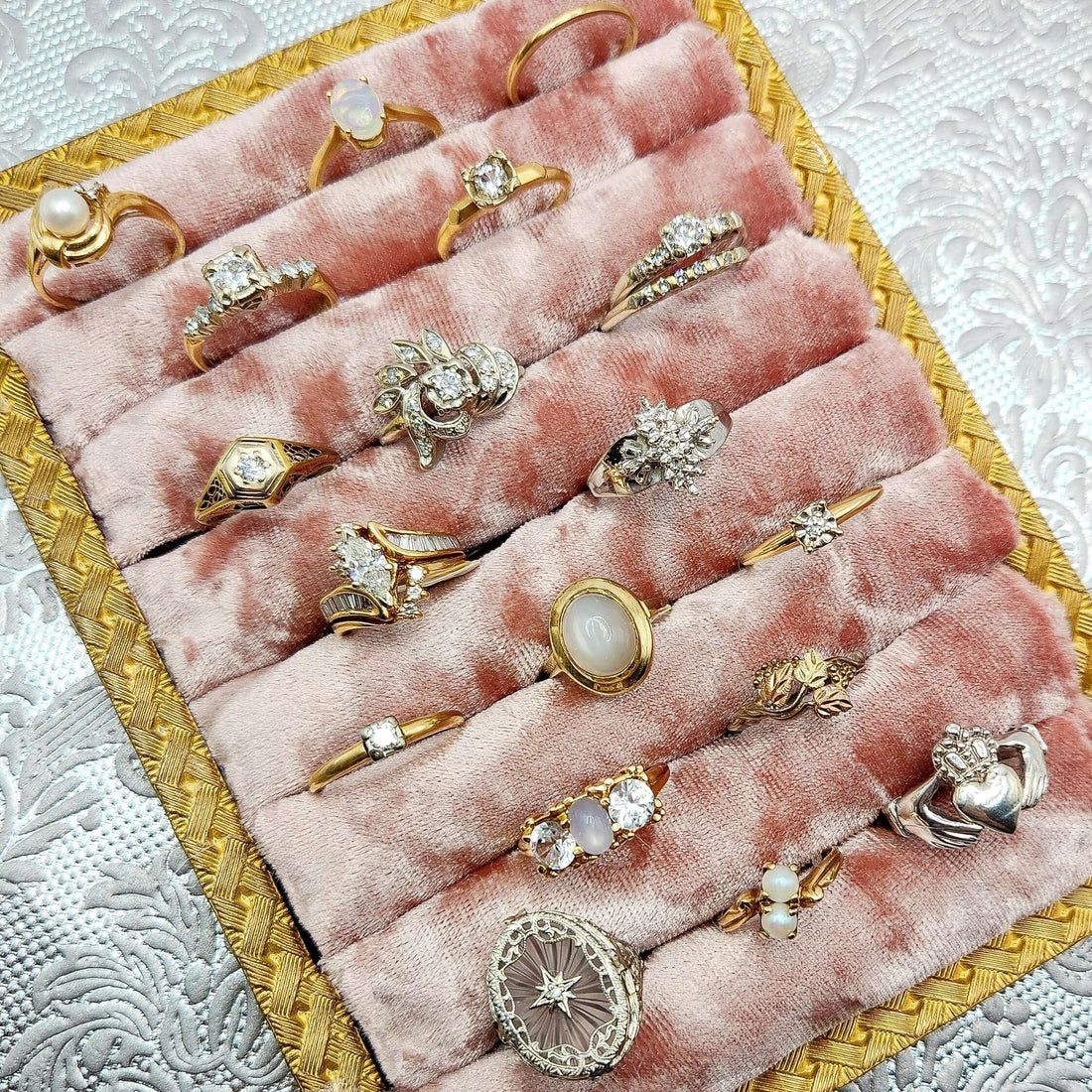
5 Things to Know When Engagement Ring Shopping
by Dani Chavez
With the new wedding season just around the corner, I've seen an increase in articles discussing engagement ring trends, and I can't help but feel frustrated by some of the misleading information out there. Having worked as a sales associate in antique jewelry stores, I’ve often educated customers about the key qualities of engagement rings they tend to overlook.
1. Not all gemstones are suitable for engagement rings!

Opal and Amethyst are too soft for engagement rings. Image: The Gemmary
I want to highlight this because it’s a key factor many people overlook when searching for the perfect engagement ring. Every day, I get the chance to help customers avoid selecting a soft gemstone for their ring, which can be damaged in just a few years. It makes a difference!

Diamond Engagement Rings. Image: The Gemmary
Have you ever wondered why diamonds are the most popular choice for engagement gemstones? They are Earth's hardest naturally occurring substance and can withstand daily wear and tear. Generally, it is recommended to stick to gemstones that rank between 7 and 10 on the Mohs scale of mineral hardness.
Suitable Gemstones: diamonds, corundum (sapphire and ruby), topaz, alexandrite, chrysoberyl, spinel, aquamarine, morganite, and garnet.
Unsuitable Gemstones: opal, pearl, quartz (Amethyst, citrine, smoky quartz), moonstone, chalcedony (agate, jasper, onyx, chrysoprase, carnelian), glass, hematite, amber, peridot, coral, mother-of-pearl, marcasite, and turquoise.
Wear With Care Gemstones: tourmaline, spodumene (Kunzite and hiddenite), and emerald.
Handle gemstones with significant natural inclusions, such as tourmaline (7-7.5) and emerald (7.5-8), with care. A strong impact can cause the stone to fracture along these natural inclusions.
If you must have these stones in your engagement ring, ensure they have the proper protection in the mounting, like a bezel setting. Take off the ring while using your hands in intense activities like cleaning, gardening, and exercising.

1960s Pinks Sapphire Diamond Engagement Ring. Image: The Gemmary
2. Make sure your unique engagement ring can accompany a wedding band.
If you follow the traditional engagement route, you will want a wedding set, including the engagement ring and an accompanying band. I've seen this increasingly with modern brides wanting such a uniquely shaped engagement ring, like a 1950s cocktail ring, that they struggle with finding a matching band.
One option is to find a diamond band that is slightly curved to hug a wide engagement setting. These are hard to find, but any bench jeweler should be able to custom-make a band that fits around your ring.
Another option is to do what you like and wear your rings any way you choose! It's a new era.

Art Deco Wedding Set. Image: The Gemmary
3. Make sure your metals match!
I've lost count of the times customers have brought in a ring for repair because the metal does not match their wedding set. If you purchase a 14K gold engagement ring, it should be matched with a 14K gold wedding band. This principle applies equally to 10K, 18K, platinum, palladium, and rhodium.
For instance, if you attempt to pair a 10K Art Deco filigree ring with a platinum band, the band will damage the filigree.
Many people are unaware that the lower the karat of gold, the harder the alloy becomes. Pure gold, or 24K, is quite soft, making it a favorite among jewelers, but it can dent easily. I recommend considering 10K, 14K, or platinum for wedding sets, as these materials age well.

4. Keep the future in mind.
Make sure your ring can be resized in the future, as our hands tend to change over time. You don't want to take in your ring only to discover it cannot be resized, forcing you to retire it. I've also heard of customers who can no longer remove their rings and eventually have to get them cut off.
The main point is to avoid purchasing a delicate or flimsy ring with a very thin shank or a band with detail circling it. Also, be cautious about resizing the ring too much, as some gemstone settings depend on pressure, and excessive resizing can cause the stones to pop out of the mounting.
 Garnet Inclusion in Diamond. Image: Wikipedia
Garnet Inclusion in Diamond. Image: Wikipedia
5. Diamond inclusions are not a bad thing.
Modern diamond assessment uses the world-recognized standard of the Four Cs: cut, clarity, carat, and color. These four factors allow one to appraise a diamond's quality and assign a value.
When Americans buy diamonds, we tend to focus on carat size; bigger is always better in the US. If so, you can compromise on the clarity or color to get a more affordable, larger diamond.
Inclusions are naturally occurring internal characteristics of a diamond that form during creation. A trained gemologist can highlight these clarity characteristics to help you identify your diamond. Whenever you take in your ring for cleaning or repair, look for that inclusion when you get the ring back to ensure your stone is still there. There are recent news stories about unscrupulous jewelers and stores switching gemstones on clients.
